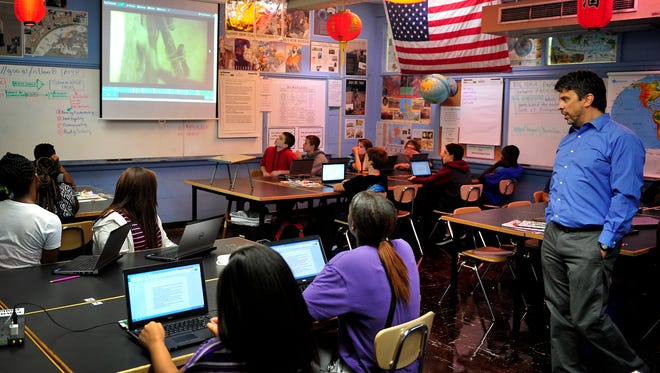Teaching history is often thought to be an easy subject to teach. People think you are just reciting facts, and lecturing on a topic, but is teaching history really that easy? The answer is no, and it never has been. History has always been “taught” through a lecture based method, and nowadays is led with PowerPoints and Google Slides, but that is not actually teaching history. That is giving your students an endless amount of facts and information they will never find relevant, and will soon quickly forget as they exit your classroom the same day. So why have teachers continued to do it for decades? Well it is easy for them, but it’s not teaching history. While originally that was the best way to teach history, that hasn’t been the case for decades. As technology advanced, so did every aspect of our society, except for education. Education feels stuck. Almost like it can’t decide if it wants to progress and adopt new ways of teaching, or if it wants to stay put and do what has always “worked”, and history has been at the forefront of that since day one.

As the world increasingly grows more digital and technologically based, education should follow the same suit, and evolve with this new and expansive digital world. Teaching history is and should be a much more involved and unique experience that is often ignored for the ease of lecturing. Every year more and more digital tools are introduced as new ways to teach. Tools that allow you to reformat presentations to make them more interactive like Sutori, or using Story Maps to flesh out and deepen your students’ understandings on relevant topics.
With the abundance of tools it can be daunting at first as you try to sift through them and figure out what works best for you and your classroom, but once you have, teaching history and your classroom enters a new era. An era that should have been entered much earlier. You don’t have to overhaul your entire curriculum just to adopt these new tools. I don’t think that is necessarily the right way to go about it unless you are centering your curriculum around digital aspects, and understand how it can be done. Instead, teachers should adopt these tools and modify the aspects of their curriculum and class structure to use these new tools.

Integrating technology and new digital tools is something you can do very easily. You can start off by just taking basic history classroom work like notes to start out. You could start off by giving your students a guided note document, and have them navigate a Sutori, Prezi, or similar tool before going over it as a class. Starting off simple would be the best for someone who isn’t as technologically savvy as some new teachers may be. However with a little hard work you could quickly implement these, and boost the quality of learning for children. The more interactive the better it is for the students. Its always good to give students choices and chances to show off their skills, whether that be poster making or making digital products.
History should be an interactive subject. Tying back to the beginning it should not just be lecturing to students about facts they need to memorize. It is so much more than that. History is like solving your own mystery. Teaching students how to navigate research, use historical thinking, and in this day and age decipher if something is “fake news” or not are important skills to know for learning history digitally, and unraveling their own historical mysteries. You could even integrate their phones into your lessons, and whether you like it or not they will have their phones and they will be on them.
One way this could be done is by have your students make an Instagram or Twitter from the perspective of a historical figure, or have them tweet like they are witnessing a historical event. That way it has them using historical thinking in a more interactive way, to help foster a deeper and lasting understanding. If we as teachers can’t properly educate our students on history, and have them make lasting connects on why it is important. Then we have failed as teachers, and we have failed our students.
—Sources—
Barth, Rick, “Distance Learning on Insta: Using Instagram Posts & Stories to Co-Create and Share Student Ideas,” Teaching Commons – Kalamazoo College, August 25, 2020. https://teachingcommons.kzoo.edu/2020/08/25/distance-learnign-on-insta-using-instagram-posts-stories-to-co-create-and-share-student-ideas-alyssa-maldonado-estrada
De Chantal, Julie, Digital Storytelling: A Beneficial Tool for Large Survey Courses in History, The History Teacher 54, no.4 (August 2021): 709-729.
European Schoolnet. “Interactive Classroom: Smartphones Support Learning in and out of School – Switzerland.” YouTube, June 11, 2015. https://www.youtube.com/watch?v=x4WmvmUcOKI
Oldham, Rhett, “4 Ways to Integrate Smartphones Into Your Classroom.” Education Week – Global Learning, October 16, 2018. http://blogs.edweek.org/edweek/global_learning/2018/10/4_ways_to_integrate_smartphones_into_your_classroom.html?cmp=SOC-SHR-FB
The Educator Staff, “How to Help Students Spot Misinformation,” The Educator Online, August 7, 2018. https://www.theeducatoronline.com/k12/news/how-to-help-students-spot-misinformation/253223
T. Mills Kelly, “Thinking: How Students Learn About the Past” (Chp. 1) in Teaching History in the Digital Age, Ann Arbor: University of Michigan Press, 2013. https://doi-org.proxy006.nclive.org/10.2307/j.ctv65swp1.6